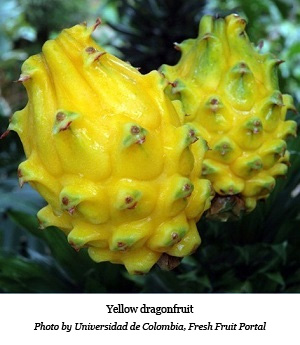Researchers from the Universidad Nacional de Colombia (UN) in Palmira have discovered a quick and easy method to enhance yellow dragonfruit crops, with regeneration through organogenesis.
 A UN release highlighted that out of around 1,600 species of cactuses, some 35 of them – including dragonfruit – had strong potential as crops. In general, the cactus family is known for its optimized use of water, which can be 5-10 times more efficient than conventional crops.
A UN release highlighted that out of around 1,600 species of cactuses, some 35 of them – including dragonfruit – had strong potential as crops. In general, the cactus family is known for its optimized use of water, which can be 5-10 times more efficient than conventional crops.
The release also pointed out that these cactus fruits, consumed either fresh or processed, had a high content of soluble solids, leading to good viability on a commercial and agroindustrial level.
UN professor María Caetano said that in the case ofSelenicereus megalanthus, known commonly as yellow dragonfruit or yellow pitaya, the plant propagated naturally through cuttings (cladodes) or seeds, disseminated by birds or other animals.
“Therefore, for purposes of cultivation, sexual propagation is not recommendable, as the plants require too much care and can take four to six years to reach their reprodutive stage,” she said.
Based on this, experts have devised new methods to propagate the species, such as tissue culture which consists of isolating part of the plant and artificially giving it the right physical and chemical conditions so that the cells can express their induced potential.
“Tissue culture development has been described by many scientists for cactuses. However, the studies for the Colombian species are very scarce; therefore, we are heading up research to develop a clonal propagation and regeneration protocol for yellow pitaya, with the view of implementing a system of seedling production and an assisted breeding program, via genetic transformation,” Caetano said.
In conjunction, the scientists have compiled a yellow dragonfruit genotype, covering outstanding morphoagronomic characteristics such as weight, the fruit pulp-to-skin ratio, soluble solids in degrees Brix, carbohydrates, ether extract, energy, pH and others.
“The explants used correspond to disinfected adult plant zones and meristematic tissue (lateral borders) obtained from in-vitro plantlets, coming from seeds germinated in petri dishes. In these borders, the vegetative and reproductive structures are formed,” said Diego Caetano Núñez, a doctorate student in agricultural science.
As a result, the study showed that the regeneration route observed and the indirect organogenesis constituted the first step for establishing genetic transformation assays for dragonfruit with biotechnological strategies.
“For the first time this protocol was standardized. The tested explan (border) presented a great part of the vegetative structure of the plant, responding in an effective way to stimuli,” Caetano Nuñez said.
Source: Fresh Fruit Portal
